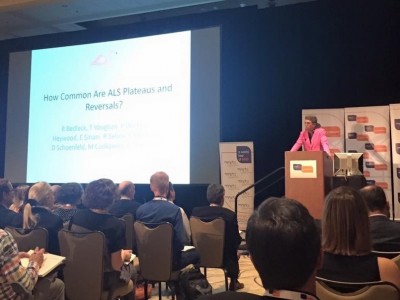Once it starts, ALS almost always continues to progress, disable and shorten the lives of its victims. Very rarely, a patient with a confirmed diagnosis of ALS gets better on validated ALS outcome measures. The ALS Reversals Program at the Duke ALS Clinic focuses on understanding these ALS reversals in order to replicate them in other patients. That’s why the funds raised by The LVH ALS Foundation support the ALS Reversals Program. We believe ALS reversals will be the key to finding a cure.
In 2019, LVH ALS Foundation’s Research Endowment Reaches $1,000,000.
The LVH ALS Foundation’s Research Endowment for the Duke ALS Clinic has now reached $1,000,000. This is an amazing accomplishment and Dr. Bedlack’s team has some exciting findings from and future plans for the ALS Reversals Program we are funding. There are 2 arms to this program: St.A.R. (Study of ALS Reversals) and R.O.A.R. (Replication of ALS Reversals).
St.A.R.
The St.A.R. program began with Dr. Bedlack and his colleagues at Mass General Hospital and PatientsLikeMe working to operationally define an ALS Reversal based on an analysis of a large database called PRO-ACT. This work shed important light on the natural history of ALS progression that was not previously well understood. Namely, that progression is not a straight line. Many patients with ALS experience periods where the disease stops, or even gets a little better for a while; this finding has major implications for future clinical trials. Less than 1% of patients experience a 4-point improvement in the ALS Functional Rating Scale that lasts 12 months or more; this is one way to operationally define ALS Reversals for future study. This work was selected for a prestigious platform presentation at the 2015 International Symposium on Motor Neuron Disease, which was delivered on December 10, 2015 as shown here:
This work was also published in the highly competitive peer-reviewed journal Neurology and the article can be read here: How common are ALS plateaus and reversals?
Based upon colleague feedback from the presentation and the article, Dr. Bedlack decided to define ALS Reversals as “independently confirmed cases of ALS in which there is a dramatic and sustained improvement in at least 1 objective outcome measure.” So far they have been able to confirm 41 ALS Reversals defined in this way.
All ALS Reversals are being entered into a common database so we can begin to determine what might be different about these patients in terms of demographics, concomitant medications, and past medical history. An analysis of the first 36 ALS Reversals showed that these cases are different from more typically progressive ALS in terms of being younger, more likely to be male, and more likely to progress faster. Interestingly they are not different in terms of their family history (10% of ALS Reversals have a family history of ALS). ALS Reversals are also more likely to be taking certain alternative or off label treatments, most notably curcumin. You can read this article here: ‘‘ALS reversals’’: demographics, disease characteristics, treatments,and co-morbidities
In early 2019, Dr. Bedlack and his team are taking a closer look at the genetics and the environmental exposures of the ALS Reversals.
Genetic samples have been collected and should be analyzed in late 2019 through a partnership with a group called CReATe. We hope to find an “ALS resistance gene” that we can explore to cause ALS reversals to occur more often.
An environmental risk factor questionnaire has now been administered. Answers are being compared to participants in the National ALS Registry. Preliminary analysis suggests that there is one significant difference: ALS Reversals were more likely to be employed as carpenters or cabinet makers compared to everyone in the Registry. Could it be that some exposure in this occupation somehow “immunizes” against future ALS? This work is being presented at the American Academy of Neurology meeting on May 6, 2019 and Dr. Bedlack will brainstorm this interesting finding with colleagues there.
R.O.A.R.
In the R.O.A.R. Program, Dr. Bedlack and his colleagues are conducting small pilot trials, testing things that patients were using when they experienced an ALS Reversal. Because the signal they are looking for is so large (most ALS trials look for a 20% slowing in progression, not an ALS reversal), these pilot trials can have some very unusual design features that should appeal to many patients and families, including:
-Few exclusion criteria
-No placebos
-Few required in-person visits (instead they will use virtual visits where patients are studied from their own homes)
-Results available in real-time
-Protocols published on the Internet (so that patients who cannot get into the trials can try the same thing with their own local doctor).
The first thing tested in R.O.A.R. was a supplement from soybeans called Lunasin. This was a collaboration between Duke and PatientsLikeMe. Unfortunately, the study found no evidence that Lunasin could slow, stop or reverse ALS, and it had some significant GI side effects. But the novel study design worked very well. It was the fastest enrolling ALS trial in history, patients showed that they could (and would) accurately measure and record outcomes throughout a 6-month period from their homes. You can read this study here: Lunasin does not slow ALS progression: results of an open-label, single-center, hybrid-virtual 12-month trial.
The second R.O.A.R. trial, of curcumin, is being planned for later in 2019. You can read the rationale here: ALSUntangled 44: curcumin.
For additional information about the ALS Reversals Program, please visit our our website at www.alsreversals.org.

